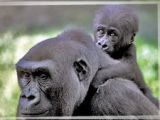Why did humans' ancestors start to walk on two feet? The debate is more vivid than that if it was Britney Spears or not in her last video, and only in the last year it has come with several theories, from bipedal (two feet) walking in the tree of the orangutans, to energy saving. Now, add a new one: Lia Amaral, from the University of S?o Paulo, in Brazil, says in her research published online, in journal "Naturwissenschaften", that bipedalism could have been determined, at least partially, for a safer transport of heavier human babies.
All apes transport their young clinging to their long body hairs from birth, a trait essential for the infant's survival. The transporting pattern modifies as the infant gets older. Newborns cling to their mother's stomach, often being helped by her.
A few months later, they pass on the mother's back, like a rider, and this transport means is used for years, till the young moves around completely independent. But, this method of transporting the infants imposes weight limits in them for safety reasons.
A complex mechanical research of the issue in various apes (gibbons, orangutans and gorillas), focusing on the traits of ape hair, infant grip, adult hair density and transporting position, revealed the link between infant weight, hair friction and body angle resulting in a safe transport of the young.
These patterns proved to be mechanically not applicable for heavy infants in case of bipedalism. The knuckle-walking on all fours of gorillas and chimps appear to impede their young from slipping off their backs.
Reduced body hair in our ancestors could have triggered bipedality, as an evolutionary necessity for infants' survival, for a safer infant carrying, as hair clinging was no longer possible.
"Safe carrying of heavy infants justified the emergence of the biped form of movement", wrote Amaral.
Even if an adult gorilla female is at least double in size than a woman, her offspring is just half the weight of a human infant. "This evolution to bipedality has important consequences for the female of the species", wrote Amaral.
Her theory points that females had their arms and hands occupied with carrying the offspring, while males and juveniles had freed their arms and hands for other activities. But, women having their hands occupied had limited options for food gathering and could survive only in very cooperative groups.

 14 DAY TRIAL //
14 DAY TRIAL // 
